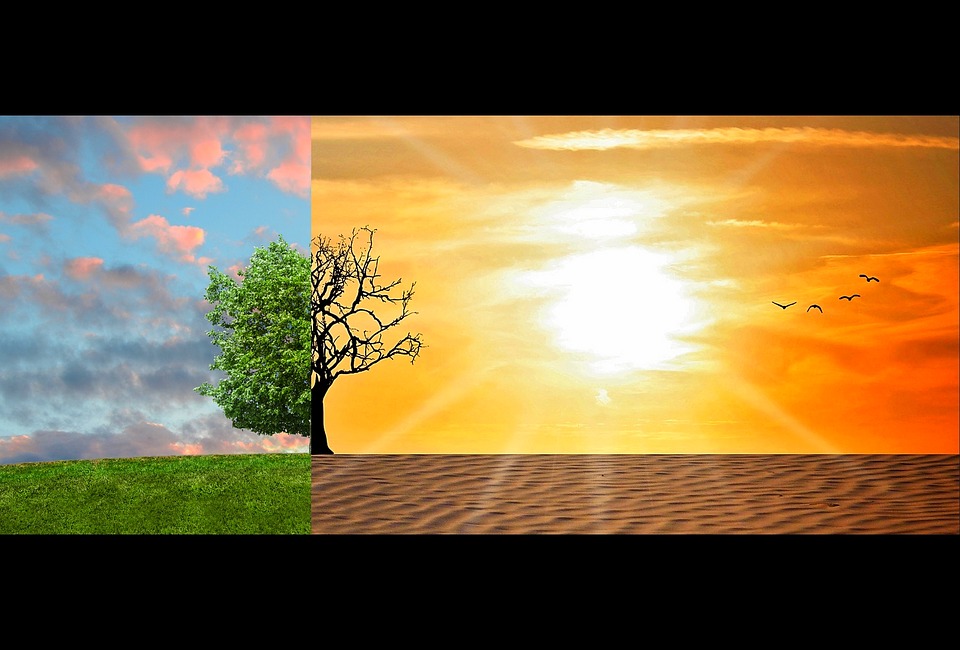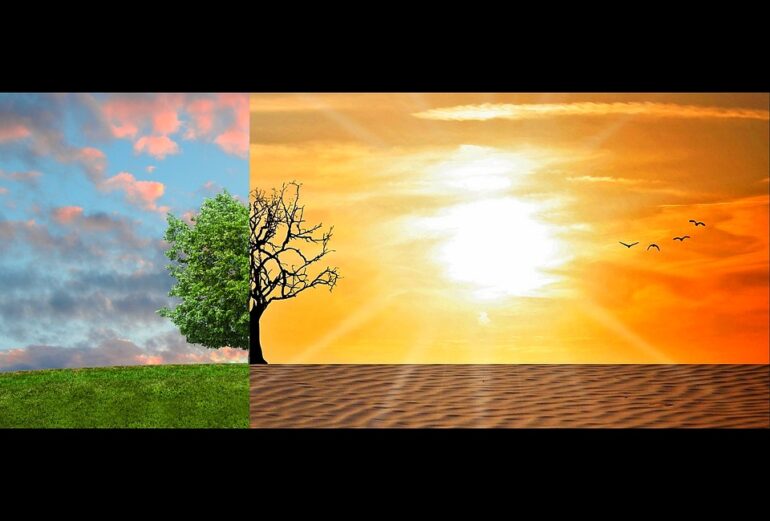Kateryna Horina
Canada is warming twice as fast as the rest of the world, according to the Changing Climate Report released this week.
The report presented by Environment and Climate Change Canada on Monday says human behaviour must change immediately in order to slow the shift.
Elizabeth Bush, a climate science adviser within the Climate Research Division of Environment of Climate Change, told Humber News that warming is globally caused primarily by emissions of carbon dioxide from human activity.
“This is from fossil fuel combustion and also deforestation and other land use changes,” she said on Tuesday.
“In addition, we know that land masses are warming a lot more than the oceans, and Canada is a large land area. So this is another reason why Canada is warming more than the global average.”
The one-of-a-kind study was in the works for years and is just a first part of a series to increase public awareness on the topic.
The document covers the following aspects:
- Temperature changes
- Changes in rainfall and snowfall
- Changes in climate extremes
- Changes in snow and ice
- Changes in freshwater availability
- Ocean changes
- Sea level change
- The future predictions
Also, the report contains the different predictions for the future in low versus high emission scenario.
“I like to remain optimistic that the science that we have can really help motivate people to understand that there are very real choices ahead of us in terms of what kind of a future we want,” said Bush.
“Not only for those of us alive now but for our children and grandchildren.”
Temperature changes
According to the report, three of the past five years were record-breaking hot in Canada.
“Canada’s climate has warmed and will warm further in the future, driven by human influence,” the report said.
“Both past and future warming in Canada is, on average, about double the magnitude of global warming.”
Since 1984, when the first available records became available, the annual average temperatures in Canada have increased by 1.7 degrees, and by 2.3. degrees over Northern Canada.
The greatest warming has occurred in winter.

Observed changes (°C) in annual temperature across Canada between 1948 and 2016, based on linear trends. From Chapter 4 Figure 4.3.
While both natural changes and human activities have lead to the observed warming, the human factor is dominant.
According to the findings, it is likely that more than half of the warming in Canada is caused by human activities.
Dan Kraus, who is a Senior Conservation Biologist with the Nature Conservancy of Canada, told Humber News there are basically two main things that people do that cause warming.
“One is that we’re just emitting too much carbon dioxide into the air, but the other thing is through land use change and that by clearing forests and grasslands and other natural habitats,” Kraus said.
“In Nature Conservancy of Canada one of the climate change solutions that we really want to make sure are included is protection and restoration of natural habitat.“
‘2 very different futures’
The effects of global warming are not only evident in many parts of Canada, but are going to intensify in the nearest future.
However, the power of further damage done caused by climate change can be changed.
“The rate and magnitude of climate change under high versus low emission scenarios project two very different futures for Canada,” report reads.

The low emission scenario demonstrates the possible damage done in case of continued growth of greenhouse gas emissions.
The limited warming scenario can only occur if Canada, as well as the rest of the world, reduce carbon emissions to near zero before the end of the century, and substantially reduce emissions of other greenhouse gases.
Bush says that it’s really important to get tat message out so that everybody will feel empowered to contribute to tackling climate change.
“Everybody can make a difference by helping to reduce emissions,” she says.
“Individuals can do things like carpool more, take public transit or ride a bicycle to get to school and around the city; they can look for energy efficiency appliances, can look at their air travel and see if there are options for reducing that and generally reducing the amount of consumption and encouraging recycling.”
Kraus says he’s hopeful the change will be made.
“I’ve been around long enough to have witnessed things like acid rain which, when I was a kid, I was quite concerned that that was going to mean that we weren’t going to have fish in any of our lakes,” he says.
“But thanks to multinational actions we were able to reduce some of those emissions and acid rain is not nearly the problem that it was 25 or 30 years ago.”
Changes in rainfall and snowfall
According to the report, there has been a shift towards less snow and more rain.
Over the current century, precipitation is expected to continue to increase across the country.
However, under a high emission scenario, the summer rainfall in southern Canada will be reduced.
Change in climate extremes
The extreme temperatures in Canada have changed along with the mean temperature increase.
“Extreme warm temperatures have become hotter, while extreme cold temperatures have become less cold,” the report said.
According to the document, most of the observed increase in temperatures is caused by human influence.
The warming also leads to extreme fire weather in parts of Western Canada.

The prediction for the future is that extremely hot temperatures will become more frequent and more intense.
“Unfortunately, it sometimes takes disasters for people to respond to environmental issues,” said Kraus.
“And sadly through things like an increase in extreme weather events, or extreme fire events, flooding of coastal areas; we may see more disasters before we step up and take action to stop climate change.”
“This will increase the severity of heatwaves, and contribute to increased drought and wildfire risks,” the report said.
“While inland flooding results from multiple factors, more intense rainfalls will increase urban flood risks.”
At the same time, it is uncertain how it will affect snowmelt-related flooding.
Changes in snow and ice
The proportion of land and marine areas covered by snow and ice have decreased during the past three decades.
At the same time, permafrost temperatures have risen, the report said.
However, these changes are not really different from those observed in other northern regions.
“Observed changes in snow and ice features across Canada present a coherent picture of a warming climate: fall and spring snow cover, the duration of seasonal lake ice cover across the Arctic, and summer sea ice extent have decreased; glaciers have thinned, and permafrost has warmed.”
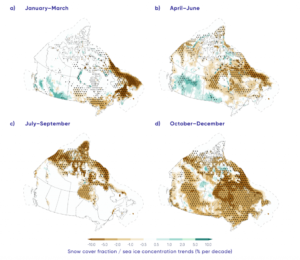
Terrestrial snow cover fraction and sea ice concentration seasonal trends for 1981–2015. Snow cover fraction is the proportion of time the ground is covered by snow. A decline of 10% per decade indicates a decline of approximately 3 days per month per decade in snow cover. Sea ice concentration is the percentage of area that is covered with sea ice. Stippling indicates statistical significance. Dashed line denotes limit of Canadian marine territory. From Chapter 5 Figure 5.2.
According to the report, the changes are a part of a response to increasing temperatures.
“As you reduce the amount of snow and ice cover you expose the darker ground or water underneath and this allows more absorption of sunlight,” says Bush.
“And that leads to more heating so this is what we call a positive feedback on the climate system.”
Given the fact the further warming is unavoidable, these changes will also continue.
Under a medium emission scenario, most small ice caps and shelves in the Canadian Arctic will disappear by 2100.
The glaciers across the western Canada mountains will lose 74% to 96% of their volume by late century.
By the mid-century, spring lake ice-break will be 10-25 days earlier and a fall freeze-up 5-15 days later.
Changes in freshwater availability
According to the report, the availability of freshwater is changing depending on seasons, and there is an increased risk of water supply shortages in summer.
Warm winters and early snowmelt lead to the higher winter flows in streams and rivers; and the small snowpacks and loss of glacier ice will produce lower summer flows.
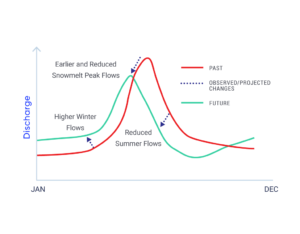
Schematic diagram showing past and future projected changes in the seasonal distribution of streamflow in many snow-fed river basins across Canada.
At the same time, warmer summers are increasing surface water evaporation that leads to reduced summer water availability.
However, many other indicators, such as annual streamflow magnitudes, soil moisture content and droughts have been stable for the most part.
Ocean changes
According to the report, oceans surrounding Canada became warmer, more acidic and less oxygenated.
Loss of oxygen and ocean warming will intensify with further emissions of greenhouse gases, the report says.
Ocean acidification will also increase due to carbon dioxide emissions, and these changes can threaten the health of marine ecosystems.
The predictions for the oceans surrounding Canada is to get warmer over the century.
Mostly it is caused by greenhouse gases emissions, and the future depends on the further emission scenario.
The ocean surface is projected to become less salty (with the exception of waters south of Atlantic Canada) over the rest of the century due to the changes in precipitation and ice melting.
Sea level change
In many areas of Canada, it is expected to increase coastal flooding due to sea-level rise.
These changes are a combination of global sea-level rise and local land uplift.
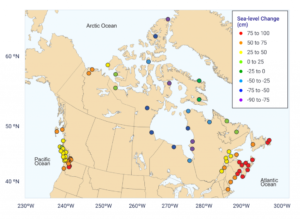
Projected relative (local) sea-level change along Canadian coastlines at the end of the century. Changes in local sea level are a combination of global sea level rise and local land subsidence or uplift. Projections shown are the median projection based on a high emission scenario (RCP8.5) and are relative to the average conditions in the 1986–2005 period. From Chapter 7 Figure 7.16.
Not only in Canada, but globally, sea level has risen and is going to continue to rise.
At the same time, the local sea level is projected to fall in the areas where the land is uplifting fastest (for example, in Hudson Bay).
As a result of larger waver and storm surges, the loss of sea ice in the Arctic and Atlantic Canada will increase the risk of damage to both coastal infrastructure and ecosystem.

